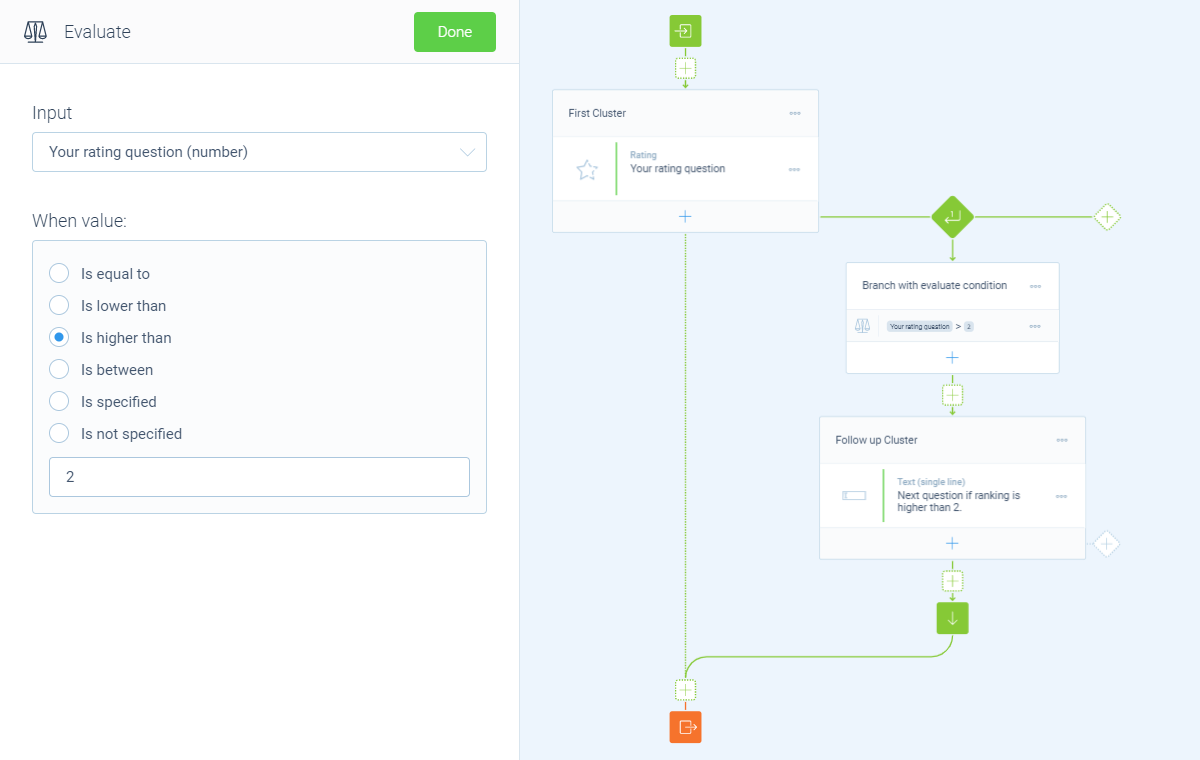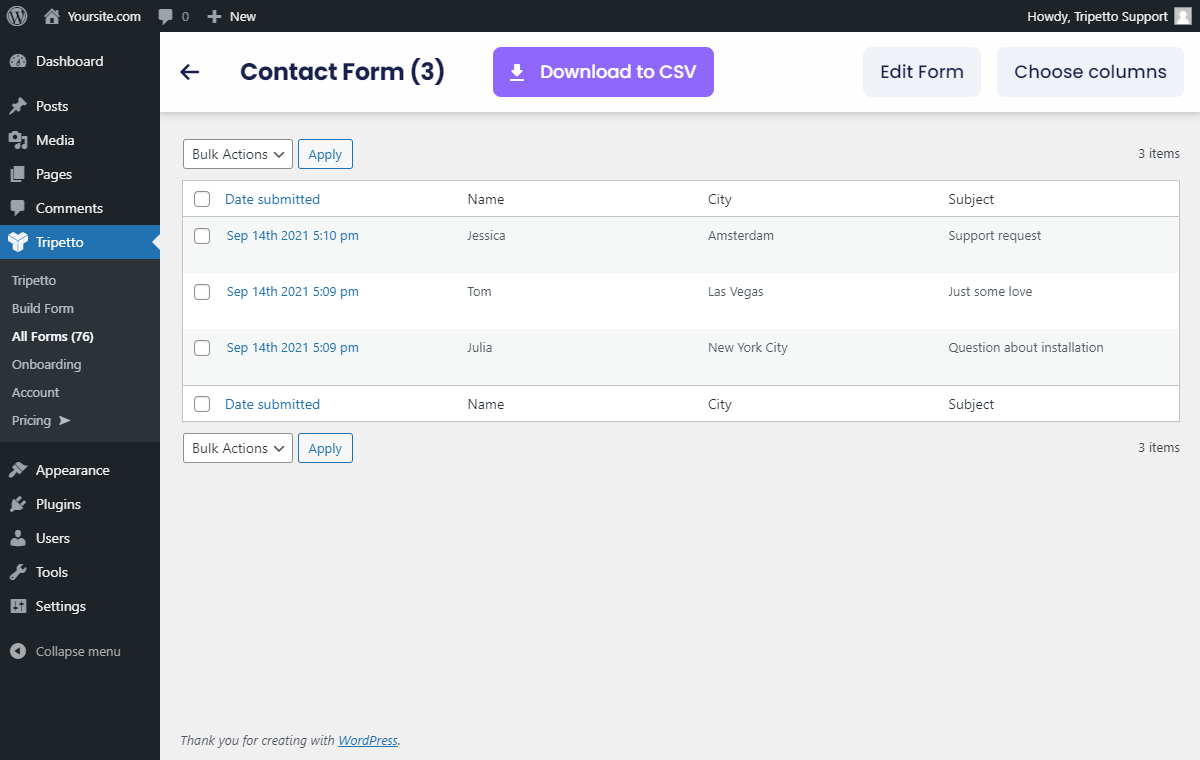
How to handle WordPress form submissions correctly - Complete Guide (2022)
Handling WordPress form submissions can be challenging. Read this complete 2022 guide on how WordPress form plugins like Tripetto can help you with this.
Forms play a significant role in almost every aspect of a business. From collecting customer feedback to running marketing campaigns, forms are an essential way to collect data.
But if you’re using conversational, customized forms, you’re going to face a problem: What happens after you’ve collected that data? And how can you ensure you get the best high-quality data from your forms?
In this post, we’ll explore how to handle form submissions in WordPress, and how to create a form that can be customized to fit specific needs. We’ll also compare the best plugins for creating conversational, high-converting forms.
What are WordPress forms used for?
WordPress site owners will know that collecting data via forms is often an interesting way to interact with your users and customers. WordPress forms can be used to gather all kinds of data, which then can be used for numerous purposes. A few possibilities are:
- Collecting user feedback and data. For example, feedback on your products and services, which can then be used for marketing, product development and improvement, and list building.
- Conducting market research. For example, asking customers about their preferences and buying habits, which then can be used for your own marketing funnels.
- Managing support requests. For example, giving your users the opportunity to easily contact you via a contact form, so you can provide top-notch support.
All those different kinds of WordPress forms result in form submissions with valuable data for you and your business. Next step is to determine how you can store that data the best way for your purposes.
Why would you need to handle form submissions?
Form submissions are essentially the raw data collected through forms. The fact that you have collected that data is great of course, but the next step is to handle those form submissions so you can use the data. There are many reasons why you need to handle the collected data properly:
- You might need to store the data collected by your forms in a database or elsewhere on your site for further action. For example, think of a use case where you’re using a form for collecting customer data or running a marketing campaign. You probably want to store that data, so you can act on that later on.
- You might want to send notifications or emails based on the information collected through your forms. That can be a simple confirmation email, including a copy of the entered data, but it can also be follow-ups that a user receives after form completion, like a PDF file with tips and tricks on a certain subject.
- You might want to analyze the data collected through your forms, for example if you’re using a form for conducting market research and you want to analyze the overall outcome of that.
- You might want to connect the data collected through your forms with other online services, so you can create automation processes that save you time and money.
So now we know that we want to handle our form submissions and why we want to do so, let’s see how we can achieve that.
How to handle WordPress form submissions?
In general, there are 2 mains ways of handling form submissions in WordPress: manually, or automatically (using a WordPress plugin).
- The manual method involves creating a form from scratch using code, and then manually exporting form submissions or data in a format that you’re comfortable with. This is a long and tedious process and is only used by developers.
- The alternative and much easier method is to create forms and handle form submissions using a WordPress plugin. Everything having to do with such a form is then handled automatically by the plugin.
Clearly, handling WordPress form submissions automatically via a WordPress plugin is the preferred route. WordPress is the leading open-source CMS, but although it’s a solid base for your website, it does not include a proper way to add forms to your site. Luckily, you can extend and customize WordPress just for your needs by installing plugins that you need for your purpose. In this case we’re looking for a WordPress form builder plugin that helps you with building forms and handling form submissions. Let’s dive into 3 popular form plugins in WordPress that can help you with this.
1. Tripetto
Tripetto is an all-in-one solution for creating powerful, deeply personalized, and smart forms. It’s known for its powerful logic features, so you only ask the right questions, based on the already given answers. Another unique feature is that you can display each form in 3 different form layouts, including a Typeform-like layout and a chat layout.

Collected data with Tripetto forms can be sent via email notifications. Besides that, the collected data is always fully stored right inside your own WordPress database, even in the free version. There are no connections to any external infrastructure! That makes handling form submissions really easy, because you simply have all your data with you.
The free version of Tripetto is already very generous. Upgrading to a paid plan with all pro features starts at $99 per year.
2. Gravity Forms

Gravity Forms is a popular WordPress plugin which lets you create responsive forms. It is good for users who want to easily create complex forms on their WordPress site. Collected data can be sent via email notifications and can be stored in your database.
The major downside is though that the free version is quite limited, and it requires multiple paid add-ons to make your forms truly usable. Licensing starts at $59 per year, but that still doesn’t include all features that you need for most form purposes.
3. WPForms

WPForms is one of the most well-known plugins in general in WordPress. Therefore, it’s a solid choice to build your WordPress forms with. By default, collected data is only mailed to you though and not stored in your database. That’s a big downside, because this keeps you from being able to properly use and analyze your collected data.
Upgrading to a paid plan does unlock the possibility to store the collected data, but the annual pricing starts at $79, and that plan will not be sufficient in most cases.
How Tripetto helps you create forms and handle form submissions
Overall, Tripetto has everything included that you need to build a high-converting form for your WordPress site and to handle your form submissions decent. Because of the flexibility of Tripetto you can use it to create all kinds of forms, like contact forms, support forms, feedback forms, surveys, quizzes. Basically any kind of form that you want to collect form data with. Let’s see how Tripetto helps you to build your forms and next how Tripetto handles your form submissions.
How you build forms in Tripetto
After installing the Tripetto WordPress plugin to your WordPress site, you can start building forms right away.
Logic
Tripetto’s form builder works as a storyboard, which helps you with structuring the logic flows in your form. Logic flows help you to make your form smart and only ask the right questions, based on the earlier given answers of each respondent. This makes your form to-the-point, which will minimize drop-offs and result in a higher completion rate.

Form layouts
A unique feature of Tripetto is that you can display your form’s front-end in 3 different form layouts, which are named ‘form faces’ in Tripetto:
- Autoscroll layout, which displays one question at a time and automatically scrolls through the form
- Chat layout, which presents questions and answers in a chat format, including chat bubbles and avatars.
- Classic layout, for a more traditional format to present multiple questions at a time.

Action blocks
Tripetto includes all different question types that you need to collect your data, like text input fields, dropdown, multiple choice, picture choice, ratings, etc. Next to that it also includes ‘action blocks’, which can perform advanced actions inside your form. Those include an advanced ‘calculator‘ block to perform calculations with entered data, a ‘hidden field‘ block to gather WordPress variables and a ‘set value‘ block to prefill and update values throughout your form.

How Tripetto handles your form submissions
In regard to handling form submissions, Tripetto can help you with any purpose you have in mind for your data. Earlier in this article we distinguished 4 ways to use your data. Let’s see how Tripetto relates to those:
- Store - Tripetto stores all your collected data into your own WordPress database. This gives you data autonomy, keeps your data secure and makes it easy to use flexibly. You can view, manage and delete all form submissions right from the Tripetto plugin in your WordPress Admin.
- Send - Tripetto can send automated notifications to email and Slack for each new form response that you receive. Those notifications can include all submitted form data. It’s also possible to send email notifications to respondents of your form, for example to confirm the form submission.
- Analyze - From the Tripetto WordPress plugin you can easily export all your data to a CSV file, so you can download it to your computer. From there on you can use that data to analyze it, for example via Excel, Google Sheets or any other spreadsheet editor.
- Connect - Tripetto includes features to send your collected data to a webhook automatically. With that you can connect your data to other online services and automate any follow-up processes you want to execute with your data, for example send it to your CRM or create automated support tickets in Zendesk.

Conclusion
Forms are an easy way to collect data from your users - whether it’s user feedback or building a mailing list, or any other type of form. WordPress is an ideal platform to help you with that. There are many plugins that allow you to create forms in WordPress.
Tripetto is one of those WordPress plugins and comes with excellent features to build smart, conversational forms - using an intuitive drag-and-drop builder, professional templates, and conditional logic - without any coding whatsoever! And Tripetto includes everything you need to handle your form submissions the right way, whether you want to store, send, analyze and/or connect your data.
Tripetto Pro includes all features to help you with handling form submissions, like email and Slack notifications and webhooks. Pricing starts at $99 per year for a single-site license and includes all pro features. This comes with a 14-day money-back guarantee – no questions asked!

